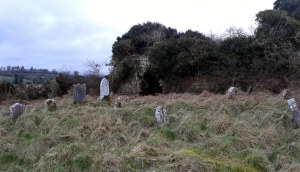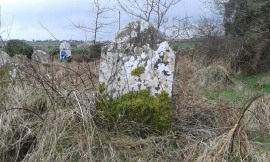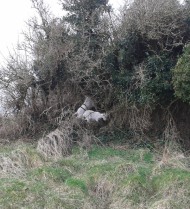There is an old graveyard down the road from our house. It lies in the middle of a dairy farm and dates back to somewhere about 500 AD.
In a former life I used to be a professional archaeologist and I always find these places really interesting for many reasons. Like so many tiny rural graveyards this one was never ‘taken in charge’ by the local council, instead it was left to the community to look after and as with all such places the families buried within the grounds have either started to die out or move away. Gradually, over the years, the remains of the church start to become covered in ivy. Briars and scrub start to cover the headstones.
Unusually, in my opinion anyway, for someone who is interested in tidying up a disused churchyard the owner of the surrounding land sought advice. Instead of just rushing in headlong with a knapsack sprayer or a mini-digger he got in contact with the National Monuments section of the Department of the Environment. He arranged to meet up on site with their representative and, because he knew of my past career, he invited me along too. After a look around and a long chat a very simple suggestion was put forward. Goats!
For the last month or so four male goats have been steadily munching their way through the overgrowth. Nearly all the ivy within 3ft of the ground is devoid of leaves and you can see how the tussocks of grass that have built up are loosening as the goats keep nibbling away at the edges and the inside starts to rot. The change hasn’t been massive yet but it’s really starting to happen, every time I drop down to take a look I can see more headstones and can get into more areas.
So if you ever here of someone or some group thinking about tidying up an area suggest goats! They’re a lot more environmentally friendly than chemicals, a lot better for the archaeology, the graves and any remaining ruins than machines and most importantly a lot easier on your back than doing the work by hand.




This is really great to hear about! Several of my ancestors are buried there, but we’re just not quite sure where exactly—according to family knowledge, the headstones haven’t been legible since the late 19th century at least. Thank you so much for posting about this, it’s a lovely little glimpse of home.
I’ll try to keep a few more posts coming about the progress or the tidy up. Personally I’ve never noticed any Seale graves but there are more headstones showing up every day. If I see one i’ll let you know.
This is one of the most creative, upbeat, heartening things I have read in a month! Please post updates.
Thanks, I hope to keep updates flowing over the coming months.
Pingback: The Goats in the Graveyard – pt. 2 | Laois Smallholding
Pingback: The Goats Are Going Home | Heritage House Abbeyleix
just read your blog. How did the graveyard turn out ? How long did the four goats take to clear it? What breed of goat did he get.?
Hi Mary,
The graveyard is still a work in progress believe it or not. The goats ate all the ivy off the lower portions of the walls, up to about 6 feet from ground level, and stripped the bark off all the blackthorn and other bushes and trees. When all the bushes died back we went in and removed their remains. The goats are in there as a maintenance program at the moment but they don’t really eat very much grass so they’re not of massive use once any fresh ivy or scrub growth is removed each year. I’m thinking that it’s about time that the goats were replaced with sheep who should do far better job of keeping the grass tidy now.
It took the goats about 2 years to really get the graveyard under control but if the graveyard had been well fenced and the goats didn’t escape so often it could probably be done in about a year, we ended up having to put an electric fence on top of the wall to keep the goats in.
The goats were essentially feral mountain goats though there was probably some breed in there somewhere. As the original goats were all male they have over the years they have been visited by a number a females of various breeds, Toggenburg and British Alpine amongst them. In my opinion any breed of goat would do but the wild nature of the original stock gave us a lot of headaches trying to keep them in place.
If you’re thinking about doing this yourself or want any more information contact me again and I can give you more information about what worked and what didn’t.